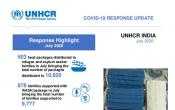India
Operation: India
Location
{"longitude":83,"latitude":22,"zoom_level":5,"iso_codes":"'IND'"}
By clicking on the icons on the map, additional information is displayed.
The boundaries and names shown and the designations used on this map do not imply official endorsement or acceptance by the United Nations.
Key Figures
| 2019 year-end results | |
| 1,400 | children enrolled in accelerated learning programmes |
| 1,200 | people of concern with specific needs received multi-purpose cash grants |
| 300 | people of concern were provided with entrepreneurship / business training |
| 4,500 | women received sanitary materials |
| 2,100 | people were reached through 12 quick impact projects that benefited both refugees and host communities and fostered peaceful coexistence |
| 2020 planning figures | |
| 1,700 | children enrolled in accelerated learning programmes |
| 1,500 | vulnerable people receive multi-purpose cash grants |
| 385 | refugees participating in entrepreneurship/business training |
People of Concern
0%
Decrease in
2019
2019
| 2019 | 207,334 |
| 2018 | 207,848 |
| 2017 | 207,665 |

[["Refugees",195105],["Asylum-seekers",12229]]
Loading ...
India
< Back
2019
{"categories":[2015,2016,2017,2018,2019,2020],"budget":[14.714199194,15.0618463,15.230436229999999,15.81443432,16.16823089,13.33189265],"expenditure":[6.1390603,5.49998666,6.6833987299999995,5.71950218,6.083500859999999,null]}
{"categories":[2015,2016,2017,2018,2019,2020],"p1":[14.612301274,14.987333289999999,15.124166279999999,15.633434320000001,16.01740689,13.172643650000001],"p2":[0.10189792,0.07451300999999999,0.10626995,0.181,0.150824,0.159249],"p3":[null,null,null,null,null,null],"p4":[null,null,null,null,null,null]}
{"categories":[2015,2016,2017,2018,2019,2020],"p1":[6.05843666,5.43533496,6.57782877,5.64382429,5.987085179999999,null],"p2":[0.08062364,0.06465169999999999,0.10556996,0.07567789,0.09641567999999999,null],"p3":[null,null,null,null,null,null],"p4":[null,null,null,null,null,null]}
Loading ...
CHOOSE A YEAR
- 2015
- 2016
- 2017
- 2018
- 2019
- 2020
Operational context
Although not a signatory to the 1951 Refugee Convention, the Government of India provided protection and assistance to refugees, including some 203,000 Sri Lankans and Tibetans in 2019. A further 40,000 refugees and asylum-seekers of other nationalities were registered with UNHCR in 2019.2019 was marked by several major developments in India, including the abrogation of special status of Jammu and Kashmir and splitting of the latter state into two Union territories, and the release of the final National Register of Citizens in Assam State, which found some 1.9 million people to be excluded at this stage, potentially putting them at risk of statelessness, pending exhaustion of administrative and judicial remedies. The situation of Rohingya refugees remained precarious, causing some to return to Myanmar.
Population trends
By the end of 2019, UNHCR had registered some 40,000 people of concern - some 27,700 refugees and 12,300 asylum-seekers. Rohingya refugees constituted the largest group (60%), followed by Afghans (27%). Around half of all registered people of concern in India lived in locations outside Delhi.India also continued to host Sri Lankan refugees, including some 59,400 living in Government-managed camps and an additional 34,300 living outside of camps. UNHCR did not register these refugees but worked with the Governments of India and Sri Lanka to facilitate voluntary repatriation for those seeking to return. In 2019, UNHCR assisted nearly 1,000 Sri Lankans to return home and supported an additional 1,000 refugees of other nationalities to find durable solutions through resettlement and complementary pathways, facilitated or spontaneous return, or naturalization.
Achievements
- UNHCR strengthened refugees’ access to protection, assistance and information by introducing a free helpline.
- Though its advocacy, UNHCR increased children’s access to national education systems from 50% to 55% and ensured that 80% of people of concern had access to health care.
- Refugee social enterprises earned an overall income of INR 11.9 million through UNHCR’s livelihoods strategy and access to markets via the “MADE51” program.
- In order to raise awareness and strengthen advocacy on the risk of statelessness, UNHCR engaged with a range of stakeholders including civil society, academia, and the United Nations country team through lectures and roundtable discussions.
Unmet needs
- Rohingya refugees continued to live in unsanitary, often inaccessible conditions.
- Limited financial and human resources resulted in a long waiting period (over 300 days) between asylum-seekers being interviewed and receiving notification of first instance decisions.
- Over 1,000 refugees and asylum-seekers were denied education, health care, skills development, labour market and child protection interventions due to funding limitations.
- Just over one-quarter (some 1,200) of people with specific needs obtained financial assistance, leaving the majority facing risks to their health, well-being and dignity.
Operational environment
While India has been a generous host to refugees for many years, particularly to Sri Lankans who continue to reside in Tamil Nadu, the past two years have been marked by a shrinking of the traditional protection space offered to urban refugees. In 2019, the opportunities for engaging the government on matters pertaining to refugee protection remain limited. Nevertheless, UNHCR continues to engage key government counterparts and collaborate closely with the full range of stakeholders, including newly identified partners.In 2019, India will be hosting around 41,000 mandate refugees and asylum seekers registered with UNHCR. Rohingya and Afghan refugees will constitute the largest refugee caseload under UNHCR’s mandate, with a smaller number from the Middle East and Africa mostly residing in urban areas.




















